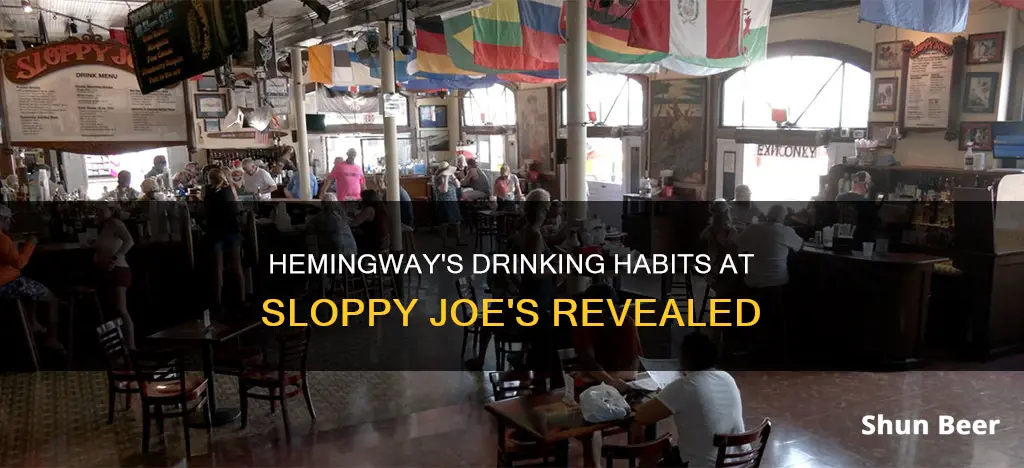
Ernest Hemingway is known to have frequented a bar called Sloppy Joe's, which was founded on the day Prohibition was repealed. The bar was located in Key West, Florida, where Hemingway lived for about 12 years. It was originally called the Blind Pig and was owned by Joe Russell, a friend, customer, and fishing companion of Hemingway's. The bar was later renamed the Silver Slipper and then, at Hemingway's urging, Sloppy Joe's. The name was taken from a bar in Havana, Cuba, that Hemingway and Russell often visited. Today, Sloppy Joe's is a Key West icon and proudly displays its Hemingway connection.
| Characteristics | Values |
|---|---|
| Name of bar | Sloppy Joe's |
| Location | Key West, Florida |
| Date opened | 5th December 1933 |
| Founder | Joe Russell |
| Type of bar | Saloon |
| Type of drinks | Beer, scotch, whiskey, gin, rum |
| Notable patrons | Ernest Hemingway, John Dos Passos, Waldo Pierce, J.B. Sullivan, Hamilton Adams, Captain Eddie Saunders, Henry Strater |
| Hemingway's relationship with Joe Russell | Fishing companion, modelled the character of Freddy in "To Have and Have Not" after him |
| Other names for the bar | Silver Slipper, Capt. Tony's |
| Current location | 201 Duval Street |
What You'll Learn
- Sloppy Joe's was named after a bar in Havana, Cuba
- Hemingway's friend Joe Russell owned Capt. Tony's, aka the original Sloppy Joe's
- Russell's bar was previously called the Silver Slipper
- Hemingway financed the bar's move to Duval Street in 1937
- Sloppy Joe's has been at 201 Duval Street since May 5, 1937

Sloppy Joe's was named after a bar in Havana, Cuba
Sloppy Joe's Bar in Key West, Florida, was named after a bar in Havana, Cuba. The Havana bar was opened in 1918 by Spanish bartender José Abeal y Otero (also known as Joe Garcia and Jose Garcia Abeal). It was frequented by Americans during Prohibition, who could enjoy the alcohol they couldn't obtain back home.
The Key West bar was opened by Joe Russell in the former location of the Victoria Restaurant, which he purchased from Spanish emigrant Juan Farto. Russell had previously run a speakeasy during Prohibition and was a friend and fishing companion of Ernest Hemingway. Hemingway was a regular at both the Key West and Havana bars, and he encouraged the former to adopt the name Sloppy Joe's, after the Havana establishment.
The Key West bar was relocated in 1937, and Hemingway moved to Cuba in 1939. The Havana bar was closed after the Cuban Revolution of 1959, which saw the American clientele disappear from Cuba. It was shut permanently after a fire in 1965, but it was restored and reopened in 2013.
Mormons and Root Beer: What's the Deal?
You may want to see also

Hemingway's friend Joe Russell owned Capt. Tony's, aka the original Sloppy Joe's
Ernest Hemingway's favourite bar in Key West was indeed called Sloppy Joe's, and it was owned by his good friend, Joe Russell, a charter boat captain and fishing companion. Russell's bar was originally located at 428 Greene Street, now the site of Capt. Tony's Saloon.
Russell and Hemingway met when Russell cashed a $1,000 royalty check for Hemingway, after a bank refused to do so. They became close friends and would go on fishing trips to Havana together. Russell charged Hemingway $10 a day to charter his boat, the Anita.
Hemingway's drink of choice was Teacher's, a cheap scotch, with soda. However, on occasion, the bartender, Skinner, would make him a special rum concoction called a Papa Dobles.
Hemingway's time in Key West (1928-1938) was his most productive period as an author. During this time, he wrote "Death in the Afternoon", "The Green Hills of Africa", "To Have and Have Not", and "The Short, Happy Life of Francis Macomber".
Hemingway kept a strict schedule while writing in Key West, waking at dawn and walking to his pool house, where he wrote at an old wooden desk. After work, he would meet his circle of friends every afternoon at 3:30 at Sloppy Joe's Bar.
In 1937, Russell moved his bar to 201 Duval Street, due to a dispute with his landlord over rent. The bar was relocated overnight, with the help of a group of Key West drinkers, and it continued to operate at this new location until Russell's death in 1941.
Today, Capt. Tony's Saloon has changed little since Russell's time, with the ceiling covered in ladies' bras, business cards filling the posts around the bar, and every bar stool painted with the name of a famous patron. It remains a popular destination for visitors to Key West.
How Cowboys Enjoyed Their Beer Chilled
You may want to see also

Russell's bar was previously called the Silver Slipper
While it is unclear whether Ernest Hemingway drank beer at Sloppy Joe's, it is known that he was a frequent patron of the bar. In fact, Hemingway was so closely associated with Sloppy Joe's that his face is now plastered on t-shirts sold by the bar, and they host an annual Hemingway look-alike contest.
The history of Sloppy Joe's is deeply intertwined with that of Joe Russell, a charter boat captain and rumrunner who would become Hemingway's fishing companion for over twelve years. Before the end of Prohibition, Russell operated an illegal speakeasy in Key West, which even Hemingway slipped over to on occasion to buy illicit bottles of Scotch.
When Prohibition was repealed in 1933, Russell opened a legitimate bar called the Blind Pig, featuring ten-cent shots of gin and nickel beer. The bar was later renamed the Silver Slipper upon the addition of a dance floor. The Silver Slipper was a rowdy, come-as-you-are saloon, with a "shabby discomfort, good friends, gambling, and fifteen-cent drinks".
Hemingway and his "Mob" of literary cohorts were enthusiastic regular customers at the Silver Slipper. The author once even referred to himself as a co-owner and silent partner in the enterprise. The group would "wrangle, drink, and philosophize the days and nights away", building a legend without even knowing it.
In 1937, Joe Russell moved his bar to a new location on Duval Street, renaming it Sloppy Joe's, and taking the furnishings with him in the middle of the night. The new name was inspired by a Jose Garcia Havana club that sold liquor and iced seafood, whose patrons teased the owner about the wet, sloppy floors.
While the name and location changed, the atmosphere remained the same. Sloppy Joe's boasted the longest bar in town, a walled-off room for gambling, and a 119-pound sailfish caught by Hemingway adorning one wall.
Over the years, Sloppy Joe's has retained its unique atmosphere, with its large drinks and casual, undemanding atmosphere. It continues to welcome patrons at all hours of the day and night, just as Joe Russell's Silver Slipper did in its heyday.
Nazarite Beer Drinking: Exploring Biblical Boundaries
You may want to see also

Hemingway financed the bar's move to Duval Street in 1937
In 1937, Sloppy Joe's Bar was located on Greene Street in Key West, Florida. That year, the bar's owner, Joe Russell, got into a dispute with his landlord, Isaac Wolkowsky, who raised the rent from three dollars a week to four dollars a week. Russell decided to move the bar to a new location, but a clause in his lease prevented him from removing any furnishings or other items.
Undeterred, Russell purchased the vacant former Victoria Restaurant on the corner of Duval and Greene Streets. When his lease expired while Wolkowsky was away on a business trip, Russell recruited a group of Key West drinkers to help him move the entire contents of Sloppy Joe's—except for the building's walls—to the new location at 201 Duval Street. The move took place on May 5, 1937, and the bar remained open during the transition, with customers carrying their drinks to the new location.
While there are no records to confirm it, one version of the story claims that Ernest Hemingway financed the move. According to Monroe County historian Tom Hambright, it is possible that Hemingway gave his friend cash, even if there is no written evidence of this.
After the move, Sloppy Joe's square footage nearly doubled, but it retained its atmosphere, featuring the longest bar in town, a walled-off room for gambling, and a 119-pound sailfish caught by Hemingway adorning one wall. The bar's new location at 201 Duval Street remains its home to this day.
Beer and Bloat: What's the Connection?
You may want to see also

Sloppy Joe's has been at 201 Duval Street since May 5, 1937
Undeterred, Russell quietly purchased the vacant Victoria Restaurant building for $2,500. When his lease expired while Wolkowsky was away on a business trip, Russell recruited a mob of Key West drinkers to help him move every scrap of his bar to the new location. The move took place on the night of May 5, 1937, and remarkably, the bar never closed during the relocation. Customers simply picked up their drinks and carried them to the new address, and service resumed without a hitch.
The new location was larger than the previous one, boasting the longest bar in town, a walled-off room for gambling, and a 119-pound sailfish caught by Ernest Hemingway adorning one wall. The bar's atmosphere, however, remained unchanged, retaining its rowdy, come-as-you-are saloon vibe.
Sloppy Joe's has a rich history and has been a favourite watering hole for many notable figures over the years, including Ernest Hemingway. Hemingway was a frequent patron and had a special bond with Joe Russell, who was his fishing companion and boat pilot. The author even referred to himself as a co-owner and silent partner in the enterprise. Hemingway was also instrumental in the bar's final name change to Sloppy Joe's, inspired by a bar of the same name in Havana, Cuba, which he and Russell often visited.
Beer and Augmentin: Safe Mix?
You may want to see also
Frequently asked questions
Yes, Ernest Hemingway was a frequent patron of Sloppy Joe's.
Sloppy Joe's was a bar in Key West, Florida, where Hemingway lived for about 12 years.
It is not known what Hemingway drank at Sloppy Joe's, but he was known to enjoy a drink and was a "notorious pack rat".
Hemingway was a close friend of Joe Russell, the owner of Sloppy Joe's, and encouraged him to change the name of the bar to Sloppy Joe's.







